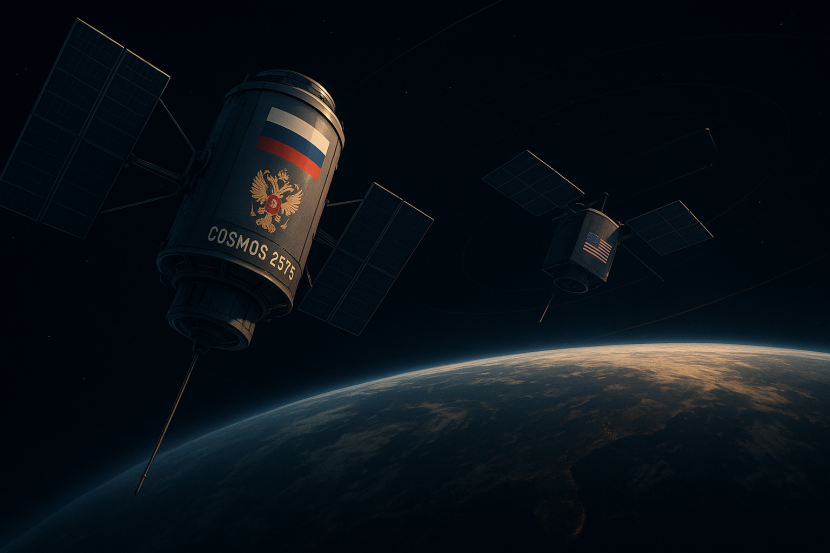In May 2024, global concern surged over Russia’s launch of Cosmos 2576. This satellite is suspected of being nuclear-armed with counterspace capabilities. This event marks a worrying new chapter in military space activities. It raises the risk of a global arms race beyond Earth’s surface. The possible placement of nuclear arms in space threatens geopolitical balance. It could also draw India into the arms race. Moreover, it endangers civilization by disrupting Earth’s climate and technological systems. With rising tensions, the critical question is: how can the world prevent outer space from becoming a nuclear battleground causing environmental destruction?
The Russian Nuclear Satellite Threat
The Pentagon confirmed that Cosmos 2576, launched on May 16, 2024, is likely a counterspace weapon capable of attacking other satellites, aligning with prior intelligence about Russia’s development of a nuclear system designed to disable satellites via electromagnetic pulses (EMPs). The satellite orbits in close proximity to USA 314, a U.S. spy satellite, intensifying suspicions of hostile intent.

Russian Denials: Moscow dismissed the claims as “fake news.” Deputy Foreign Minister Sergei Ryabkov said, “Our policy does not change from this.” However, analysts note Cosmos 2576 shares an orbital ring with USA 314, a U.S. spy satellite, raising suspicions. However, Russia vetoed a UN resolution in April 2024 aimed at preventing an orbital arms race, raising questions about its commitment to space disarmament.
Treaty Violations: If Cosmos 2576 carries nuclear weapons, it would violate the 1967 Outer Space Treaty, which explicitly bans nuclear arms in orbit. Russia is a signatory to this treaty, making the deployment a serious breach of international law.
Global and Indian Nuclear Arms Race Risks
U.S.-Russia-China Tensions
The failure of the U.S., EU, and Japan’s UN resolution highlights deep international divisions. Russia’s advocacy for a broader ban on space weapons is viewed skeptically, especially as China expands its anti-satellite (ASAT) capabilities, fueling a three-way superpower rivalry in space militarization.
India’s Strategic Dilemma
While the search results focus on Pakistan’s Shaheen-III missile (2,750 km range), India’s development of the Agni-V intercontinental ballistic missile (ICBM), with a range exceeding 5,000-7,000 km, underscores its strategic advancements. On March 11, 2024, India successfully tested its first multiple independently targetable re-entry vehicle (MIRV) using the Agni-V, enhancing its deterrence capabilities.
Accelerate ASAT programs to protect its 53+ operational satellites.
Forge alliances with the U.S. or France to counterbalance China and Russia.
Catastrophic Space Accidents and Climate Fallout
A nuclear detonation in space could trigger:
- Satellite Collapse: Debris from destroyed satellites might create a Kessler Syndrome scenario, rendering low-Earth orbit unusable for decades and crippling weather forecasting, GPS, and communications.
- EMP Effects: Modern society depends heavily on satellites. This reliance increases the risk of widespread disruption. The U.S. Department of Energy warns that an EMP attack could trigger cascading infrastructure failures.
Climate Disruption
- It might destroy the Ozone Layer, letting in more harmful UV rays.
- Soot from war could block sunlight, leading to a “Nuclear Winter” that harms global farming.
- Later, extra CO₂ might heat the planet even more, worsening climate change and global warming.
The Path Forward: Diplomacy and Deterrence
- Diplomatic Pressure: Global cooperation is essential to advance a comprehensive treaty on “Space De-Armament”. However, Russia’s UN veto power and geopolitical distrust hinder progress toward binding agreements.
- Infrastructure Hardening: Countries must invest in EMP-resistant power grids and satellite redundancy, as demonstrated by Japan and Scandinavia, to mitigate potential attacks.
- Global Cooperation: Preventing space from becoming a warzone requires transparency, but current geopolitical distrust makes this unlikely.
The deployment of nuclear weapons in space represents a grave threat to global security, environmental stability, and technological infrastructure. As tensions mount, humanity must choose between collaboration to preserve peace in space or risking catastrophic conflict and environmental disaster on Earth.


